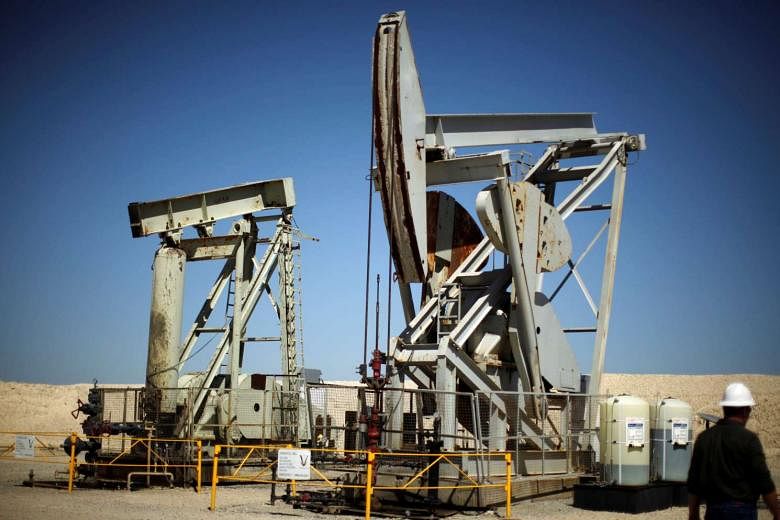NEW YORK/HOUSTON (BLOOMBERG, REUTERS) - Oil dropped below US$50 in New York for the first time since December as concerns that Opec's output cuts are failing to reign in record US stockpiles triggered the biggest slump in more than a year.
Meanwhile, senior Saudi energy officials told top independent US oil firms in a closed-door meeting this week that they should not assume Opec would extend output curbs to offset rising production from US shale fields, two industry sources told Reuters on Thursday (March 9).
West Texas Intermediate fell as much as 3 per cent on Thursday after losing 5.7 per cent the previous three sessions. Crude supplies rose 8.2 million to the highest level in weekly government data since 1982.
Mr Harold Hamm, the US shale oil billionaire, warned on Wednesday that the industry could "kill" the market if it embarks on another spending binge.
Oil had fluctuated above US$50 a barrel since the Organisation of Petroleum Exporting Countries and other countries started trimming supply for six months starting Jan 1 to reduce a global glut. While US shale output has rebounded, larger-than-expected cuts elsewhere and signs of growing demand suggest stockpiles will eventually decline, according to Goldman Sachs Group.
"People are nervous about the global supply-demand balance," said Mr Adam Sieminski, a scholar at the Center for Strategic and International Studies in Washington and former head of the Energy Information Administration. "Shale is coming back with US$50 oil and there's uncertainty about whether Opec and its partners are going to roll-over the production agreement."
West Texas Intermediate for April delivery dropped US$1, or 2 per cent, to close at US$49.28 a barrel on the New York Mercantile Exchange. Total volume traded was about 85 per cent above the 100-day average. The contract has tumbled 7.6 per cent in four days.
Brent for May settlement slipped 92 cents to US$52.19 a barrel on the London-based ICE Futures Europe exchange. It was the lowest close since Nov 30. The global benchmark crude closed at a US$2.36 premium to May WTI.
Oil market volatility, as measured by the CBOE Crude Oil Volatility Index, rose to a three-month high at the close of trading.
"We're seeing a huge spike in demand for options on the move below US$50 for WTI," said Mr Clayton Rogers, an energy derivative broker at SCS Commodities Corp.
Oil producers led by Saudi Arabia and top non-Opec exporter Russia are in an uneasy truce with US shale firms after a two-year price war that sent many shale producers to the wall.
The resulting rise in oil prices has sparked a rush of new output by shale producers, who this week outlined ambitious production growth plans across the US.
Speaking at an industry conference in the US energy capital of Houston on Tuesday, Saudi Arabia's Energy Minister Khalid al-Falih said that there would be no "free rides" for US shale producers benefiting from the upturn.
Mr al-Falih's senior advisers went a step further at the meeting on Tuesday evening with executives from Anadarko, ConocoPhillips, Occidental Petroleum Corp, Pioneer Natural Resources, Newfield Exploration and EOG Resources.
"One of the advisers said that Opec would not take the hit for the rise in US shale production," a US executive who was at the meeting told Reuters. "He said we and other shale producers should not automatically assume Opec will extend the cuts."
The Saudis called the meeting to exchange views on the market and to gauge the outlook for shale output, both sources said.
Both sources spoke about the meeting on condition of anonymity due to the sensitivity of the matter.
The meeting came after Opec secretary-general Mohammed Barkindo met hedge funds and shale producers in Houston earlier in the week, seeking to widen talks on how to tame the global glut.
Mr al-Falih said on Tuesday that global inventories had fallen more slowly than he expected in the first two months of the year, although oil market fundamentals were improving as a result of the curbs.
The inventory rise stoked concern that the glut could persist because shale supply, along with more output from Brazil and Canada, could offset output cuts by Opec and some non-Opec suppliers.
The US government expects US oil output to rise 330,000 bpd in 2017, mostly from shale, but some analysts and producers are forecasting the increase could be more than double that amount.
Opec next meets on May 25 in Vienna to discuss supply policy, and is expected to decide there on whether to extend supply curbs implemented on Jan 1.
Unlike the Opec and non-Opec state-run producers that have agreed to curb output, there is no mechanism for US independent producers and global oil majors to restrain output. Their imperatives are commercial, and they produce as much oil as they can at profit.

